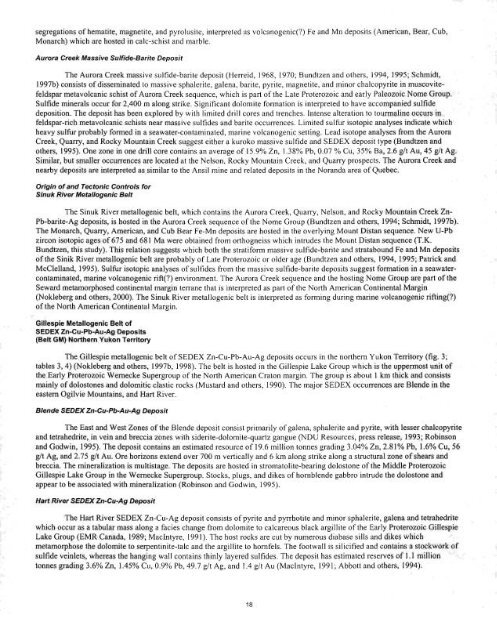Metallogenesis and Tectonics of the Russian Far East, Alaska, and ...
Metallogenesis and Tectonics of the Russian Far East, Alaska, and ...
Metallogenesis and Tectonics of the Russian Far East, Alaska, and ...
Create successful ePaper yourself
Turn your PDF publications into a flip-book with our unique Google optimized e-Paper software.
segregations <strong>of</strong> hematite, magnetite, <strong>and</strong> pyrolusite, interpreted as volcanogenic(?) Fe <strong>and</strong> Mn deposits (American, Bear, Cub,<br />
Monarch) which are hosted in calc-schist <strong>and</strong> marble.<br />
Aurora Creek Massive Sulfide-Barite Deposit<br />
The Aurora Creek massive sulfide-barite deposit (Herreid, 1968, 1970; Bundtzen <strong>and</strong> o<strong>the</strong>rs, 1994, 1995; Schmidt,<br />
1997b) consists <strong>of</strong> disseminated to massive sphalerite, galena, barite, pyrite, magnetite, <strong>and</strong> minor chalcopyrite in muscovitefeldspar<br />
metavolcanic schist <strong>of</strong> Aurora Creek sequence, which is pad <strong>of</strong> <strong>the</strong> Late Proterozoic <strong>and</strong> early Paleozoic Nome Group.<br />
Sulfide minerals occur for 2,400 m along strike. Significant dolomite formation is interpreted to have accompanied sulfide<br />
deposition. The deposit has been explored by with limited drill cores <strong>and</strong> trenches. lntense alteration to toi~rmaline occurs in<br />
feldspar-rich metavolcanic schists near massive sulfides <strong>and</strong> barite occurrences. Limited sulfur isotopic analyses indicate which<br />
heavy sulfur probably formed in a seawater-contaminated, marine volcanogenic setting. Lead isotope analyses from <strong>the</strong> Aurora<br />
Creek, Quarry, <strong>and</strong> Rocky Mountain Creek suggest ei<strong>the</strong>r a kuroko massive sulfide <strong>and</strong> SEDEX deposit type (Bundtzen <strong>and</strong><br />
o<strong>the</strong>rs, 1995). One zone in one drill core contains an average <strong>of</strong> 15.9% Zn, 1.38% Pb, 0.07 % Cu, 35% Ba, 2.6 g/t Au, 45 glt Ag.<br />
Similar, but smaller occurrences are located at <strong>the</strong> Nelson, Rocky Mountain Creek, <strong>and</strong> Quarry prospects. The Aurora Creek <strong>and</strong><br />
nearby deposits are interpreted as similar to <strong>the</strong> Ansil mine <strong>and</strong> related deposits in <strong>the</strong> Nor<strong>and</strong>a area <strong>of</strong> Quebec.<br />
Origin <strong>of</strong> <strong>and</strong> Tectonic Controls for<br />
Sinuk River Metallogenic Belt<br />
The Sinuk River metallogenic belt, which contains <strong>the</strong> Aurora Creek, Quarry, Nelson, <strong>and</strong> Rocky Mountain Creek Zn-<br />
Pb-barite-Ag deposits, is hosted in <strong>the</strong> Aurora Creek sequence <strong>of</strong> <strong>the</strong> Nome Group (Bundtzen <strong>and</strong> o<strong>the</strong>rs, 1994; Schmidt, 1997b).<br />
The Monarch, Quany, American, <strong>and</strong> Cub Bear Fe-Mn deposits are hosted in <strong>the</strong> overlying Mount Distan sequence. New U-Pb<br />
zircon isotopic ages <strong>of</strong> 675 <strong>and</strong> 68 1 Ma were obtained from orthogneiss which intrudes <strong>the</strong> Mount Distan sequence (T.K.<br />
Bundtzen, this study). This relation suggests which both <strong>the</strong> stratiform massive sulfide-barite <strong>and</strong> stratabound Fe <strong>and</strong> Mn deposits<br />
<strong>of</strong> <strong>the</strong> Sinik River metallogenic belt are probably <strong>of</strong> Late Proterozoic or older age (Bundtzen <strong>and</strong> o<strong>the</strong>rs, 1994, 1995; Patrick <strong>and</strong><br />
McClell<strong>and</strong>, 1995). Sulfur isotopic analyses <strong>of</strong> sulfides from <strong>the</strong> massive sulfide-barite deposits suggest formation in a seawater-<br />
contaminated, marine volcanogenic rift(?) environment. The Aurora Creek sequence <strong>and</strong> <strong>the</strong> hosting Nome Group are part <strong>of</strong> <strong>the</strong><br />
Seward metamorphosed continental margin terrane that is interpreted as part <strong>of</strong> <strong>the</strong> North American Continental Margin<br />
(Nokleberg <strong>and</strong> o<strong>the</strong>rs, 2000). The Sinuk River metallogenic belt is interpreted as forming during marine volcanogenic rifting(?)<br />
<strong>of</strong> <strong>the</strong> North American Continental Margin.<br />
Gillespie Metallogenic Belt <strong>of</strong><br />
SEDEX Zn-Cu-Pb-Au-Ag Deposits<br />
(Belt GM) Nor<strong>the</strong>rn Yukon Territory<br />
The Gillespie metallogenic belt <strong>of</strong> SEDEX Zn-Cu-Pb-Au-Ag deposits occurs in <strong>the</strong> nor<strong>the</strong>rn Yukon Territory (fig. 3;<br />
tables 3,4) (Nokleberg <strong>and</strong> o<strong>the</strong>rs, 1997b, 1998). The belt is hosted in <strong>the</strong> Gillespie Lake Group which is <strong>the</strong> uppermost unit <strong>of</strong><br />
<strong>the</strong> Early Proterozoic Wernecke Supergroup <strong>of</strong> <strong>the</strong> North American Craton margin. The group is about 1 krn thick <strong>and</strong> consists<br />
mainly <strong>of</strong> dolostones <strong>and</strong> dolomitic clastic rocks (Mustard <strong>and</strong> o<strong>the</strong>rs, 1990). The major SEDEX occurrences are Blende in <strong>the</strong><br />
eastern Ogilvie Mountains, <strong>and</strong> Hart River.<br />
Blende SEDEX Zn-Cu-Pb-Au-Ag Deposit<br />
The <strong>East</strong> <strong>and</strong> West Zones <strong>of</strong> <strong>the</strong> Blende deposlt consist primarily <strong>of</strong> galena, sphalerite <strong>and</strong> pyrite, with lesser chalcopyrite<br />
<strong>and</strong> tetrahedrite, in vein <strong>and</strong> breccia zones with siderite-dolomite-quartz gangue (NDU Resources, press release, 1993; Robinson<br />
<strong>and</strong> Godwin, 1995). The deposit contains an estimated resource <strong>of</strong> 19.6 million tonnes grading 3.04% Zn, 2.81% Pb, 1.6% Cu, 56<br />
g/t Ag, <strong>and</strong> 2.75 g/t Au. Ore horizons extend over 700 m vertically <strong>and</strong> 6 krn along strike along a structural zone <strong>of</strong> shears <strong>and</strong><br />
breccia. The mineralization is multistage. The deposits are hosted in stromatolite-bearing dolostone <strong>of</strong> <strong>the</strong> Middle Proterozoic<br />
Gillespie Lake Group in <strong>the</strong> Wernecke Supergroup. Stocks, plugs, <strong>and</strong> dlkes <strong>of</strong> hornblende gabbro intrude <strong>the</strong> dolostone <strong>and</strong><br />
appear to be associated with mineralization (Robinson <strong>and</strong> Godwin, 1995).<br />
Hart River SEDEX Zn-Cu-Ag Deposit<br />
The Hart River SEDEX Zn-Cu-Ag deposit consists <strong>of</strong> pyrite <strong>and</strong> pyrrhotite <strong>and</strong> minor sphalerite, galena <strong>and</strong> tetrahedrite<br />
which occur as a tabular mass along a facies change from dolomite to calcareous black argillite <strong>of</strong> <strong>the</strong> Early Proterozoic Gillespie<br />
Lake Group (EMR Canada, 1989; Maclntyre, 1991). The host rocks are cut by numerous diabase sills <strong>and</strong> dikes which<br />
metamorphose <strong>the</strong> dolomite to serpentinite-talc <strong>and</strong> <strong>the</strong> argillite to hornfels. The footwall is silicified <strong>and</strong> contains a stockwork <strong>of</strong><br />
sulfide veinlets, whereas <strong>the</strong> hanging wall contains thinly layered sulfides. The deposit has estimated reserves <strong>of</strong> 1.1 million<br />
tonnes grading 3.6% Zn, 1.45% Cu, 0.9% Pb, 49.7 g/t Ag, <strong>and</strong> 1.4 git Au (MacIntyre, 1991; Abbott <strong>and</strong> o<strong>the</strong>rs, 1994).
















